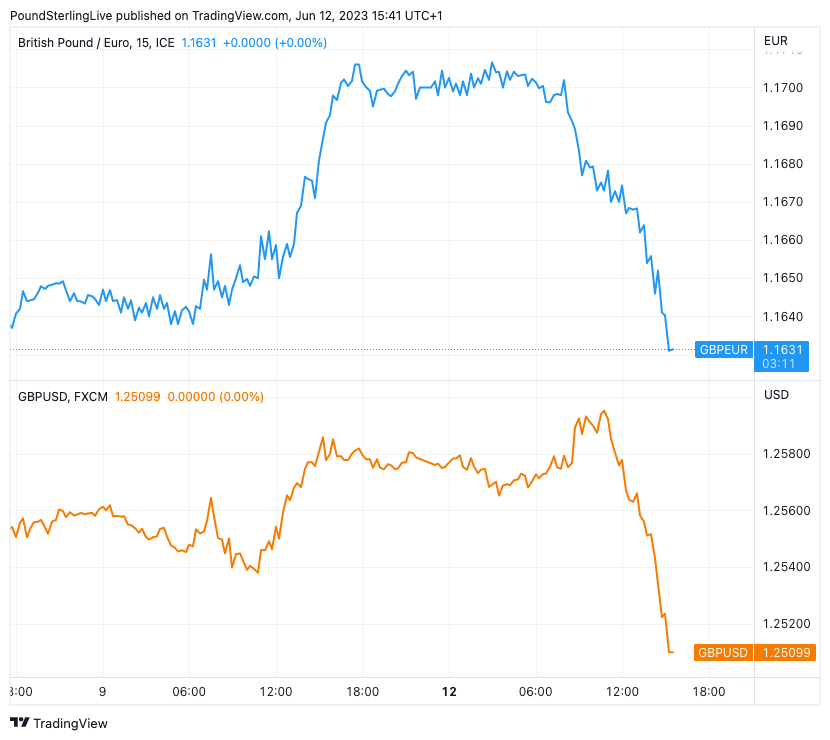Pound Sterling Retreats against Euro and Dollar As Borrowing Costs Surge Ahead of Key UK Jobs Report and a Week of Risks
- Written by: Gary Howes
-

Image © Bank of England
Pound Sterling bulls "appear reluctant... as liquidity dries up ahead of a slew of data followed by Fed, ECB and BoJ meetings later in the week."
This is according to currency analyst Paul Spirgel at Reuters, commenting on a sharp retracement in the value of the British Pound at the start of the week.
The UK currency was seen lower against the majority of its peers just hours before a key labour market print that is expected to show the UK's unemployment rate rose to 4.0% in April while wages rose to 6.1% from 5.9% previously.
The sharp declines also come alongside another leap higher in UK borrowing costs, with a key benchmark - the two-year bond yield - hitting its highest levels since the market drama that followed Liz Truss's mini-budget.
While the 'Trussenomics' meltdown in UK bond markets formed part of an adverse market reaction, the current increase in borrowing costs is the result of investors worrying UK inflation will remain elevated for longer, prompting higher Bank of England interest rates. This in turn raises the risk of a sharp economic slowdown, prompting investors to demand greater compensation (yield) for holding UK bonds.
"Yields supported by sticky inflation rather than reassuring growth data offer only questionable support for GBP," says Daragh Maher, Head of Research, Americas, at HSBC.
The slide in the Pound also suggests growing caution in the market with investors preferring to book profits on 2023's top-performing major currency in the event that the jobs figures due Tuesday undershoot expectations.
The Pound to Euro exchange rate had hit a fresh 10-month high earlier in the day before retreating a decent 0.60% to 1.1637. The Pound to Dollar exchange rate meanwhile rose to 1.26 before retreating half a per cent to 1.2514.
"Dovish MPC members favouring a rate hold could gain more sway if Tuesday's UK data hint at reduced inflationary pressures, raising the prospects of a skip, or pause, of their own at the June 22 MPC meeting, which would move GBP/USD further away from its highs," says Spirgel.
Above: UK two-year bond yields.
The Pound has found itself bid over recent weeks amidst elevated expectations for further Bank of England rate hikes, driven by a run of better-than-expected economic data releases. Should the data turn, this trend could go into reverse.
Declines against the Dollar also come ahead of a key U.S. inflation report due Tuesday and Wednesday's Federal Reserve rate decision. The Euro is meanwhile in focus on Thursday with another 25 basis point hike expected of the European Central Bank.
This is therefore a busy week for the main GBP pairs given the data due from the UK and events in the Eurozone and U.S. and volatility could be elevated.
Above: GBP/EUR (top) and GBP/USD at 15-minute intervals showing price action on Monday.
Spirgel's colleague, Peter Stoneham, has meanwhile analysed the Pound's performance on Monday and says for now price action suggests a correction is underway as opposed to a trend change.
"Technical evidence so far only suggests a correction not a reversal," says Stoneham.
"The GBP remains one of the best-performing currencies in G10, mainly due to the superior quality of the incoming UK data as well as the build-up of BoE rate hike expectations," says Valentin Marinov, Head of FX Research at Crédit Agricole. "The latter continues to boost the rate appeal of the GBP across the board."
Therefore, the Pound's period of outperformance would likely require the incoming data to remain on the firm side of expectations, with any downside misses in the numbers potentially prompting a pullback.
The UK is expected to have added 150K jobs during the three months to April when labour market figures are released on Tuesday, with the average earnings index (with bonus) expected to have increased at an inflation-boosting 6.1% in April.
UK GDP (Thursday) is meanwhile forecast to have risen 0.2% in the month of April, taking the year-on-year reading to 0.6%. A swath of industrial, manufacturing and trade data are also due for release on the day.
"Focus will be on the latest UK labour market data for May and the monthly GDP data for April. FX investors will want to see if the incoming data would give the GBP's flagging relative rate advantage another boost before buying the currency in the near term," says Marinov.













